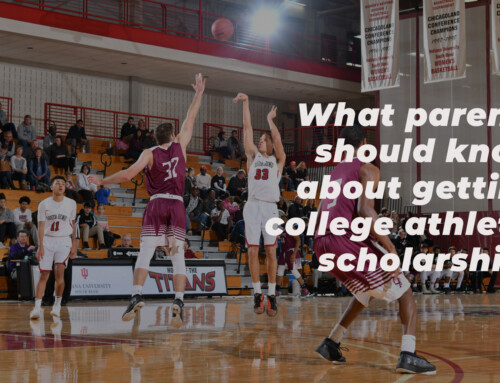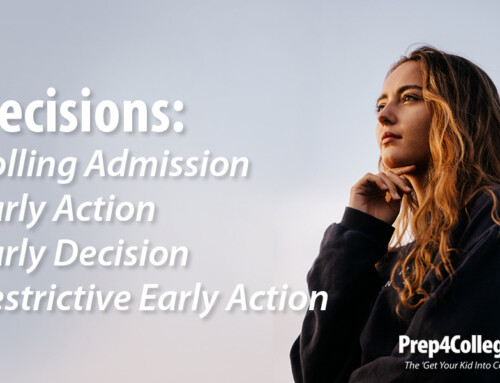 Many colleges and universities offer several types of early admissions options when applying to their school. Determining the best option for each college on your list is critical as you plan out your application strategy. It is important to understand the benefits and pitfalls of each option. Below is a rundown on each possible option.
Many colleges and universities offer several types of early admissions options when applying to their school. Determining the best option for each college on your list is critical as you plan out your application strategy. It is important to understand the benefits and pitfalls of each option. Below is a rundown on each possible option.
Early Decision (ED) – The application deadline is usually November 1. Each college is different so it is important to verify the date prior to submitting the application. Applying ED requires the student apply to only ONE college, usually his/her first choice or dream school. Each ED applicant (and parents) is required to sign a contract with the college at the time of application submission stating that if accepted, he/she will attend. The student will receive a decision usually in early December. If accepted, the contract is binding!
The upside of applying early decision is the application process is completed very early. As a reward for applying early, more students who apply are accepted as compared to those who apply regular admission. The applicant can enjoy winter vacation and relax for the remainder of the school year, while his/her friends are sweating out regular admission notifications that occur in late March
The downside is the financial aid award is not available until sometime in March. If the award is sufficient, the applicant is all set. If not, there is a major problem. Remember, a contract was signed with the college stating you will attend if accepted. The contract is binding and it is extremely difficult to back out of the contract. Even if you are able to back out of the contract, where would you go? There is no back-up plan since this was the only college to which you applied.
I do not recommend applying ED unless financial aid is not an issue or the college will give you an early financial read. An early financial read from your ED school will let you see the approximate amount of money that will be offered BEFORE applying ED. Once the amount is known, you can make an informed decision about applying ED. A few colleges offer this service, but not many. To find out if your favorite college offers an early financial read please call its financial aid office.
Early Action (EA) – Like Early Decision, it is an application plan that some colleges permit when applying early. Usually the application due date is towards the end of November, but it varies from college to college so verify the date prior to submitting the application. Many of the same perks that come with applying ED come with applying EA. More applicants who apply EA are accepted as compared to those who apply regular admission. Most acceptance, rejection or deferral notices are given out in December, so the agonizing wait is over sooner. If a deferral notice is given, your application will be considered with the Regular Decision applicants.
Unlike applying ED, applicants can usually apply to multiple colleges EA (unless your college is Single Choice Early Action or SCEA, which I will discuss next). Once accepted, a decision to attend is not required until May 1st. The applicant can wait for all acceptance offers and financial aid offers BEFORE making a decision.
I recommend applying Early Action to several of your top choice colleges or universities if the plan is available. There is no down side to applying EA.
Single Choice Early Action (SCEA) – As the name implies, colleges that offer this option only permit the applicant to apply to one college using an Early Action plan. If you choose to apply to a college using SCEA6, you cannot apply to any other colleges EA. You are on the honor system here; if you apply to other colleges EA and get caught, all your college acceptance offers can be rescinded. However, you can apply to as many colleges as you wish Regular Decision. The same acceptance terms apply to SCEA colleges as EA colleges.
I recommend applying SCEA if the college is your first choice or dream school. Otherwise, apply Regular Decision and apply to multiple colleges EA.
Regular Decision (RD) – Many colleges offer a Regular Decision application option. The application deadline is usually sometime in January, but a few colleges have a December deadline. Each college is different so it is important to verify the date prior to submitting the application.
I recommend applying RD to the remainder of colleges on your preferred list. Your application will get a fair read, although you will be competing against a larger pool of applicants than the ED or EA applicant pool. Most colleges send out their acceptance and rejection notices towards the end of March. The financial aid offer is often available at the same time.
The downside to applying RD is the larger pool of applicants you will be competing against. Also, if a college accepts the majority of its student body from the ED or EA pool of applicants, your chances of getting accepted is diminished.
If you have any other questions about selecting a college, or the admissions process, feel free to contact me through my website at www.Prep4CollegeNow.com or call me at 760.877.7200. I’d love to answer your questions!






